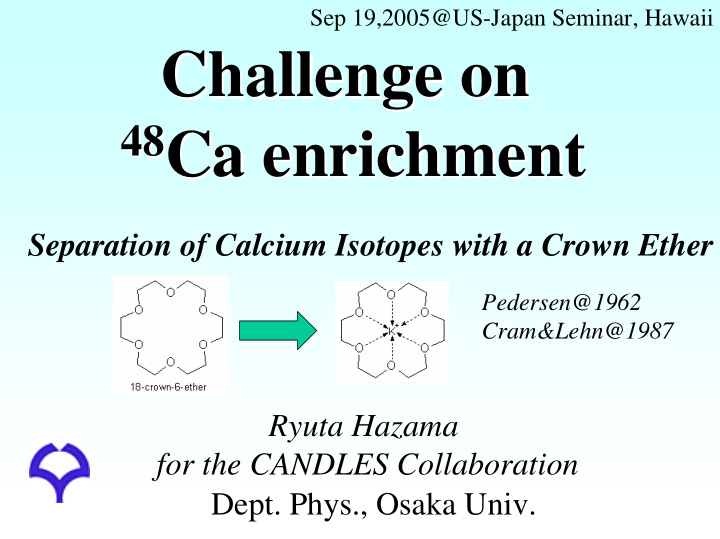



Sep 19,2005@US-Japan Seminar, Hawaii Challenge on Challenge on 48 Ca enrichment 48 Ca enrichment Separation of Calcium Isotopes with a Crown Ether Pedersen@1962 Cram&Lehn@1987 Ryuta Hazama for the CANDLES Collaboration Dept. Phys., Osaka Univ.
48 Ca enrichment • Natural abundance → 0.187% – Enriched isotope → expensive (elemag. separator;calutrons) ~200K$/g ~10g × 2 (in the world) → no gaseous compounds A.I.Karchevski at room temp. ββ isotopes; 48 Ca, 96 Zr, 150 Nd etc. Gas centrifuge
for Ca × × Liquid centrifuge? (mobility/viscosity with CaCl 2 solution & almina) Find a cost-effective & efficient way of enrichment!!!
Unique Property of Crown Ether Complexing of cations(anions) by neutral molecules is an uncommon phenomenon. Stability is ~10 4 × no-ring(crown) Crown Ether • Held by electrostatic attraction between negatively charged O- of C C - - the C-O dipoles & cation (Ca 2+ ) O O C C • How well the cation fits into the - - O Ca 2+ O crown ring C • Liquid(aq-salt)-liquid(org-crown) - - C O O C C extraction in isotopic equilibrium Dicyclohexano 18-crown-6 DC18C6 Total # of atoms in the ring # of oxygen atoms in the ring
The mean square Can be fractionated from Nuclear charge radius the most abundant 40 Ca? of Ca Two doubly magic isotopes; A parabolic behavior L.Vermeeren et al., J.Phys.G,22(1996)1517 40 Ca 42 Ca 43 Ca 44 Ca 46 Ca Ca 48 Ca isotope abundan 96.9 0.65 0.135 2.09 0.004 0.187 ce ( % )
Ca Isotope effects ~ Separation Principle 40 Ca 2+ (aq)+ 48 CaL 2+ (org) CaCl 2 aqueous 48 Ca phase 48 Ca 2+ (aq)+ 40 CaL 2+ (org) 0.07M 40 Ca Crown-chloroform organic DC18C6: Aldrich Chemical, 98.0% CHCl 3 :Nakarai Tesque, 99.0% CaCl 2 :Nakarai Tesque, 95.0% Solvent Extraction process 1.vacant extraction to reduce impu. 2.mixed & stirred for 1 hour 3. standing for 1 hour @ 7 ° C 4. LLE iterated 6 times Magnetic Stirrer B.E.Jepson&R.Dewitt, J. Inorg.nucl.Chem38(1976)1175
Isotopic Analysis by HR-ICP-MS@WERC 48 Ca/ 43 Ca= 1.385 48 Ca/ 42 Ca= 0.289 Black: A Black: A Red: B Red: B STD
Comparison 1.0020 Preliminary 1.0028 1.0010 1.0007 1.0010 Need to verify by 1.0010 1.0006 precise TIMS & 1.0009 More iterate LLE 1.0006~1.0013 ~800 iteration 0.187 � 2.0%
Major background molecular ions formed from the Ar Plasma, nebulized water and dissolved/contained air. + × m/z= + Max resolution=12000 × Enemy
How to measure 40 Ca? 1. TIMS(TRITON Thermo Electron) Only four TRITONs in Japan No-Ar 2. Reaction(collision)-cell ICPMS Perkin Elmer ELAN-DRCII@Kochi Univ. Q inside reaction-cell allows use of ammonia � can avoid interference of Ar by reaction-gas Simple collision-cell must use simple gas(H 2 , He) to limit adverse side reaction 40 Ar + 40 Ar products Ar + + 40 Ca Ar + + NH 3 + NH 3 Ca + + + Ar � NH 3 Reduce Ar + � 10 9 >10 3 NH 3
Ar + =15.76 eV 10.16eV Charge transfer is allowed Ca+=6.11 eV for Ar+, but disallowed for Ca+ Ca(6.11eV)<NH3(10.16eV)<Ar(15.76eV)
40 Ca, 48 Ca are doubly magic � A parabolic behavior mass effect Nuclear mass effect > Nuclear size&shape effect!!! This is crucial asset to realize 48 Ca enrichment (from 40 Ca)
cf. Chromium-crown(DC18C6) Similar parabolic due to the same magic # of n=28 as 48 Ca Cr T. Fujii et al., J.Phys.ChemA106(2002)6911 Nuclear mass effect < Nuclear size&shape effect!!!
How small? Evaluate each isotope effects by 3 measured ε(=1−α) ε 40-48 , ε 43-48 , ε 44-48 Bigeleisen theory ε 43-48 =a( ∆ M/MM’) 43-48 +b δ <r 2 > 43-48 +(lnK hf ) 43 Hyperfine splitting(spin) Nuclear mass effect Nuclear size&shape effect field shift effect is small! almost identical effect If the field shift effect is dominat, this method is not effective for Ca.
Summary • The preliminary largest separation factor of Ca by LLE using DC18C6 is suggested. • We evaluated each contribution ratio of the field shift/hyperfine splitting shift effect to the mass effect of Ca for the 1 st time. The contributon of the field shift effect is small, especially for 40 Ca- 48 Ca, compared with Cr. • These indications are promissing towards the mass production of enriched 48 Ca by the chemical separation method with the help of the current evolving cutting-edge tech. of microchannel chip. See the details on R. Hazama et al.,J. of Nucl. Sci.&Tech(2005)
http://wwwkm.phys.sci.osaka-u.ac.jp/~hazama/iso-wsp/workshop.html ~ October(Nov.), 2005 Please contact R. Hazama or Prof. T. Kishimoto
Microchip Technology(synthetic chemistry) Microreactor Chem. Commun. 2001, 2662
Macro)10cm cube S/V~0.6/cm 250 µ m wide,100 µ m deep, and 3cm length S/V~80/cm No-stirring,Fast!!
Recommend
More recommend